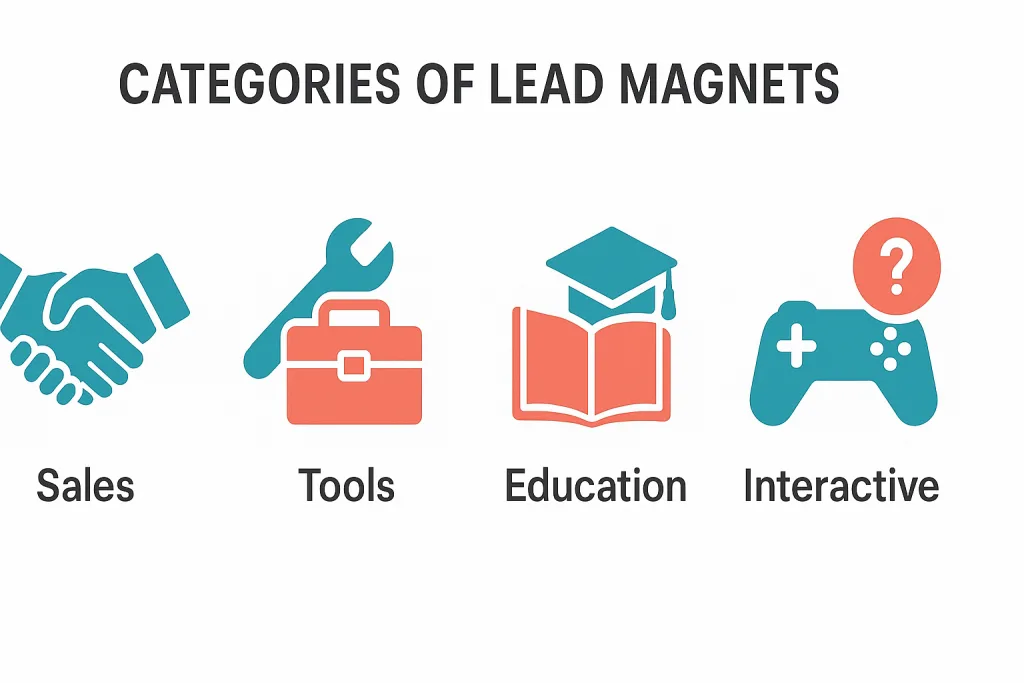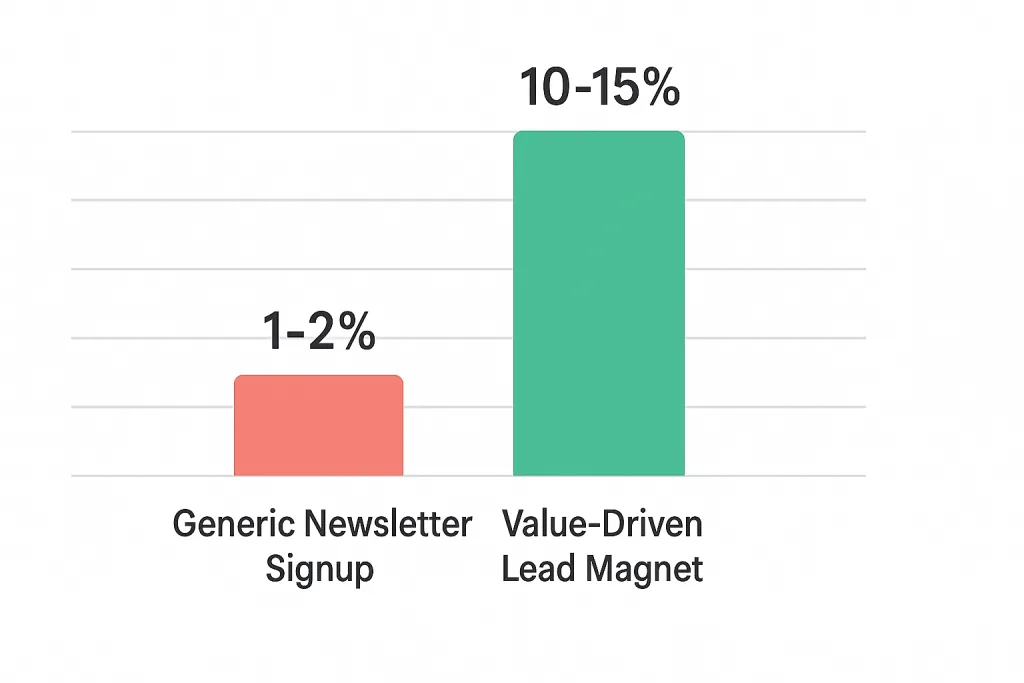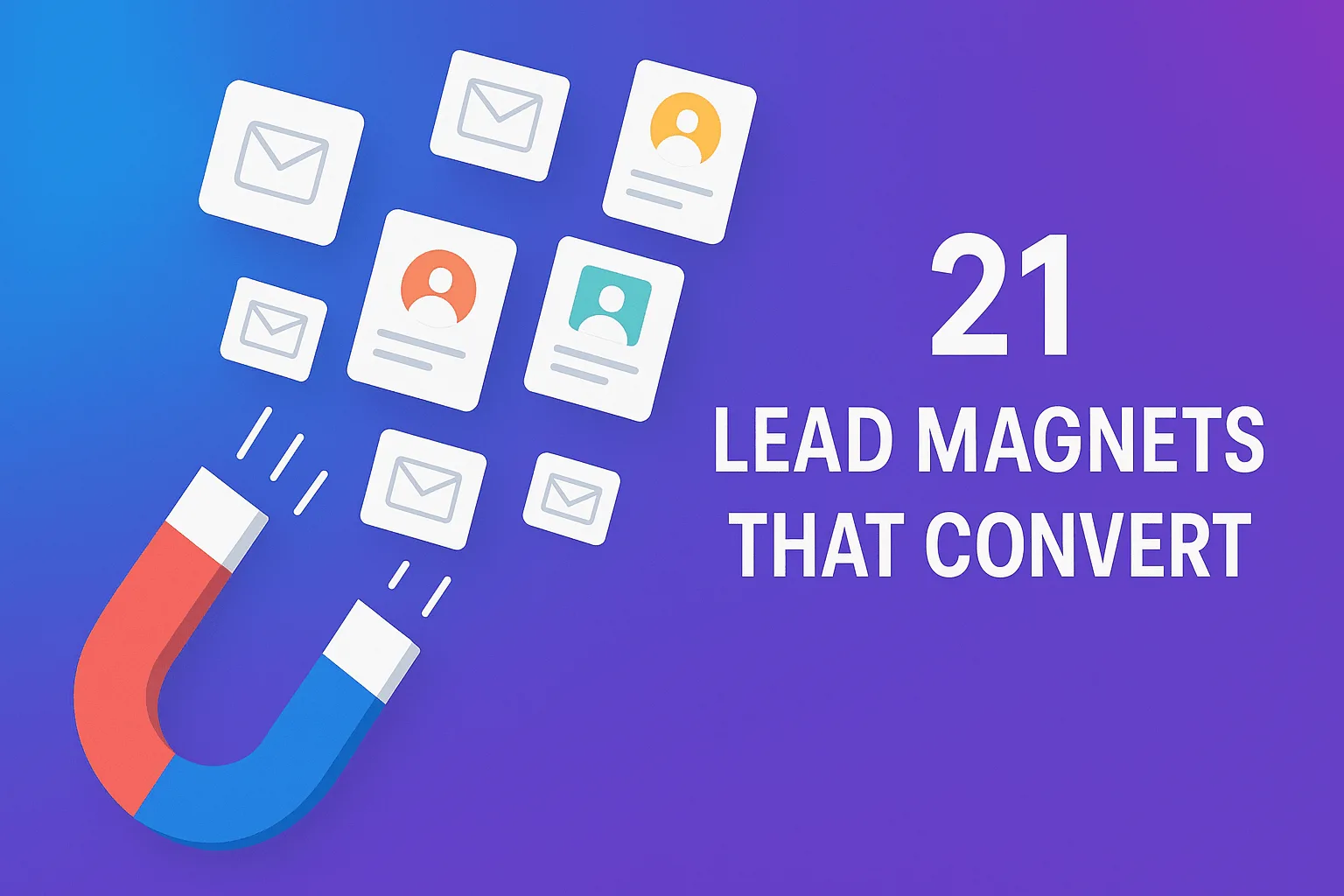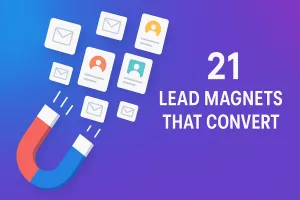Maximize Your Lead Generation Strategy
Stop wasting valuable traffic! It’s time to transform casual visitors into engaged prospects who are ready to buy from you.
Building a thriving business in 2025 requires more than just attracting visitors—it demands a strategic approach to capturing high-quality leads and nurturing them into customers. Lead magnets serve as your primary weapon in this battle, exchanging genuine value for customer contact information.
The modern approach isn’t about accumulating massive lead lists. Instead, it’s about attracting prospects who actually align with your business goals and have real conversion potential.
With competition intensifying across every industry, prioritizing quality over quantity in lead generation has become non-negotiable.
Research reveals a sobering truth: nearly 80% of marketing leads never convert without strategic follow-up, highlighting why effective lead magnets matter more than ever.
This comprehensive resource explores proven lead magnet strategies, real-world examples, and cutting-edge tools driving results today. You’ll discover everything from mobile-optimized formats to AI-powered personalization tactics, complete with actionable insights and case studies.
Quick Takeaways: Master Lead Capture in 2025
Generic pop-ups are dead. Success in 2025 demands attracting qualified prospects with lead magnets that deliver genuine value. Move beyond simple email collection—create resources that genuinely solve problems and resonate with your target audience.
Essential principles:
- Prioritize quality leads over volume for superior conversion performance
- Deliver immediate value through actionable resources like checklists, templates, and quick-win guides
- Demonstrate authority by creating lead magnets that showcase expertise and provide meaningful insights
- Increase engagement through interactive elements like quizzes, calculators, and AI-powered assessments
- Design mobile-first content that works perfectly on any device
Critical reminder: Creating great lead magnets is only half the battle. Strategic promotion through blog content, website placement, and targeted advertising puts your offers in front of ideal prospects.
Ready to build lead magnets that actually convert? This guide provides everything you need to succeed.
Understanding Lead Magnets
A lead magnet functions as an exchange mechanism—trading valuable resources or incentives for prospect information, typically email addresses and names.
The fundamental purpose? Capture attention and motivate visitors to willingly share their contact details.
Modern lead magnets have evolved significantly, incorporating advanced personalization through audience segmentation and tailored content delivery.
Effective 2025 lead magnets go beyond passive information delivery. They create interactive experiences that engage prospects from the first touchpoint.
Why Lead Magnets Are Essential for Every Business
Audiences have grown immune to generic pop-ups and value-lacking forms. The question “Why would I give my email just for a newsletter?” has become universal.
Yet email list building remains crucial. Here’s why:
Direct audience connection enables deeper engagement that advertising and social content alone cannot achieve. While paid ads and content marketing build awareness, meaningful conversion requires personal connection—understanding prospect needs and communicating one-on-one.
The more expensive your offering, the more critical this middle-funnel relationship becomes.
1. Audience Relevance
Lead magnets must address needs directly connected to your audience’s interests. For example, a “Beginner’s Guide to Email Marketing” wouldn’t appeal to HappySocks customers. Instead, offer a 20% discount or free shipping—incentives that resonate and drive action.
2. Solves Specific Problems
Focus on one clear, actionable benefit addressing a particular challenge. Rather than broad topic coverage, pinpoint single problems—like writing compelling subject lines or conducting efficient keyword research—and deliver resources offering immediate wins. This approach ensures audiences feel instant value, building trust for future engagement.
3. Instant Gratification
Speed matters. While 12-part courses offer substantial value, delayed delivery reduces engagement. Lead magnets providing immediate access—like downloadable checklists or templates—satisfy urgent needs and maintain prospect interest.
4. High Perceived Value
Value perception drives opt-in rates. Vague offers like “sign up for our newsletter” generate minimal interest. Compelling alternatives like “Exclusive 5-Step Framework for Doubling Sales” attract significantly more sign-ups. High-value lead magnets justify collecting additional details beyond email addresses.
5. Establishes Expertise
Exceptional lead magnets build credibility and authority. Educational resources particularly should demonstrate deep topic knowledge, positioning your brand as a trusted resource. This establishes credibility while priming audiences for future interactions and purchases.
Email lists provide direct access to potential customers, enabling systematic lead nurturing that builds relationships and drives conversions.
How do you build quality email lists when people ignore generic pop-ups?
The answer: value-driven lead magnets that give visitors compelling reasons to opt in.
Characteristics of High-Converting Lead Magnets
Successful lead magnets generate leads that can be nurtured into paying customers. Performance is measured by conversion efficiency—how many quality leads a lead magnet generates from the same audience size.
Target 5-15% conversion rates by following these core principles:
These principles create lead magnets that engage effectively, deliver genuine value, and establish foundations for lasting customer relationships.
Building Your Lead Magnet: Step-by-Step Process
Step 1: Analyze Competitors
Effective marketing research starts with competitive analysis. Studying direct and indirect competitors—especially high-performing ones—reveals valuable lead magnet strategies.
How to conduct comprehensive competitor research:
Meta Ads Library
The Meta Ads Library offers visibility into competitors’ current advertising campaigns. Active lead magnet promotions typically appear here. Use this resource to identify which offers and lead magnets competitors actively promote.
Blog Analysis
Lead magnets commonly appear within blog content—as content upgrades, exit-intent pop-ups, or embedded forms. Review 5-6 competitor articles to identify blog traffic conversion strategies.
Website Examination
eCommerce businesses typically feature lead magnets through homepage pop-ups, product page offers, and checkout incentives. SaaS and service businesses employ similar tactics. Conduct thorough website reviews to identify all lead magnet placements.
Header CTAs
Desktop websites typically display primary calls-to-action or lead magnets in top-right positions. eCommerce sites show cart icons; consultants and service providers often use “Contact Us” buttons. Don’t overlook these prominent placements.
Create a tracking spreadsheet documenting competitor lead magnets before building your own.
Pro Tip: Use incognito mode for competitive research. Many websites trigger pop-ups only on first visits, so private browsing reveals elements as new visitors experience them.
Step 2: Research Your Audience
If you have existing website traffic—whether paid or organic—analyze your highest-traffic blog pages and incoming search keywords. This reveals why people visit your site and what questions they seek to answer.
Where to look:
Google Search Console
Navigate to Search Results > Queries to view top search terms driving site traffic. Note keywords revealing user intent and consider creating lead magnets around these topics. This provides insights into specific questions and needs driving users to your content.
Google Analytics
In GA4, access Reports > Engagement > Pages and Screens. Filter by /blog or relevant paths using the search bar. This report identifies top pages by user engagement, helping determine which content performs best. Use these insights to create lead magnets aligned with high-interest content.
Social Media Analytics
Review performance metrics across YouTube, Instagram, LinkedIn, and other channels to identify most engaging content. Note top-performing videos, posts, and topics to inspire relevant lead magnets.
Behavior Analysis Tools
Tools like Hotjar or Crazy Egg reveal where users click and spend time on your site. Analyzing these behaviors uncovers specific interests and engagement points guiding lead magnet topics.
Tracking high-engagement content across platforms enables crafting relevant, valuable lead magnets more likely to attract sign-ups.
Step 3: Research Market Demand
Understanding audience search behavior remains essential even without significant website traffic or social media presence. Here’s how to uncover audience needs and pain points:
Amazon Books & Bestsellers
Search industry-related books on Amazon, focusing on top-rated titles. Note common themes, popular subtopics, and reader reviews to identify gaps and recurring pain points.
Facebook & Reddit Communities
Facebook groups and subreddits provide invaluable access to authentic audience conversations. Use these platforms to observe recurring questions, challenges, and trends directly from your target market.
AnswerThePublic
This tool uncovers questions and phrases people search online. Enter key topics to explore related questions, sparking lead magnet ideas addressing specific audience concerns.
Google Trends
Monitor rising trends and search interest over time. Google Trends suggests seasonally relevant lead magnets—like guides or templates for annual tasks and events.
Ahrefs or SEMrush
Research top-ranking content around your keywords. These SEO tools uncover themes, frequently asked questions, and content gaps on high-ranking pages, revealing what users want to read and learn.
BuzzSumo
Analyze top-performing content across social media platforms. Find topics generating significant engagement and create complementary lead magnets—downloadable guides, quizzes, or interactive calculators—to attract similar audiences.
Example: If you’re in financial planning and “saving money on subscriptions” trends, create a calculator helping users quantify potential savings by reducing expenses—cutting streaming services, reducing dining out, or eliminating luxury purchases.
Step 4: Select Lead Magnet Category
Lead magnets group into specific categories based on purpose and customer journey stage.

Sales-Focused Lead Magnets
Designed for bottom-of-funnel users showing high purchase intent. Ideal for moving prospects toward final sales while providing valuable insights into BOFU customers within your CRM.
Examples: Demos, Free Trials, Limited-Time Coupons, Case Studies, Free Consultations, Product Samples
Execution-Focused / Practical Tools
Created to help users accomplish tasks efficiently, these provide practical value by addressing specific problems. They convert well by offering immediate utility.
Examples: Checklists, Ready-to-Use Templates, Planners, Worksheets, Guides, Content Upgrades
Educational Lead Magnets
Ideal for products or services requiring knowledge before purchase decisions. Typically used at middle-of-funnel but also effective at top-of-funnel for brand introductions.
Examples: Mini-Courses, Webinars, In-Depth Guides, Ebooks, Case Studies, Email Courses
Interactive Engagement Lead Magnets
Encourage user participation and brand engagement, leading to higher activation rates. Versatile for both TOFU and MOFU by providing personalized solutions, entertainment, or valuable feedback.
Examples: Quizzes, Interactive Calculators, AI-Driven Assessments, Challenges, Contests, Surveys
Mobile-Optimized / Bite-Sized Content
With mobile-first browsing dominating, these lead magnets deliver value quickly and on-the-go. Crafted for mobile accessibility, ensuring seamless audience interaction.
Examples: Gated Short Videos, Infographics, Mobile-First PDF Guides, One-Pager Resources
Pro Tip: Assign points in your CRM each time users engage with lead magnets. This identifies most engaged leads, enabling focused nurturing of highest-scoring prospects.
Step 5: Build Your Lead Magnet
Creating effective lead magnets requires appropriate tools for each type.

Sales-Related Lead Magnets
For conversion-focused lead magnets, strong landing pages and compelling offers are essential.
- Instapage or Unbounce: Drag-and-drop editors with pre-made templates for professional, no-code landing pages
- WordPress + Elementor: Robust landing page capabilities with extensive customization
Useful Lead Magnets
For resources like checklists, templates, or worksheets, editable formats allow users to personalize and implement insights directly.
- Google Sheets and Google Docs: Perfect for practical lead magnets. Offer editable versions users can copy and adapt—calculators, trackers, or customized planners
Engagement Lead Magnets
Interactive lead magnets like quizzes and assessments encourage participation, making them memorable and shareable.
- Typeform: Intuitive design with interactive templates for engaging quizzes, surveys, and assessments
- Outgrow: Advanced interactive content including calculators, quizzes, and chatbots with dynamic content features
These tools accelerate lead magnet creation, ensuring high-quality, targeted resource delivery without delay.
Step 6: Promote Your Lead Magnet
Creating lead magnets is just the beginning. Simply launching and hoping for leads isn’t enough.
Three primary methods generate leads with lead magnets. Your choice depends on lead magnet type and goals.
Blog Promotion
If your blog attracts significant visitors, generate leads from this traffic. Content marketing typically generates blog traffic through quality content, then converts visitors using content upgrades.
Content upgrades—educational or useful lead magnets highly relevant to article topics—offer additional value to readers. Users reading articles feel compelled to access these complementary resources.
Best lead magnet types for blog promotion: Content upgrades, PDF resources, checklists, templates, and mini-courses.
Example: Email marketing article + content upgrade featuring 10+ email templates.
Main Website
Convert existing website traffic into leads. The most common lead magnets on company websites are sales-related.
This makes sense—visitors browsing product and service pages often need one more incentive before purchasing. A 10% discount coupon or free trial provides the perfect next step for product evaluation.
Paid Ads + Landing Pages
For new businesses or those targeting cold audiences, create landing pages featuring strong lead magnets and run Facebook Ads. This approach works exceptionally well.
Marketers commonly run ads to free resources—educational and engagement lead magnets—generating leads for upselling to paid products.
Successful marketers run cold traffic ads to free or low-ticket lead magnets (around $5), generate leads, then sell education products once prospects are ready.
Lead Magnet Examples by Category
Sales-Related Examples
Free Demo
Offering free video product demos helps potential customers learn basics without creating accounts. Extremely useful for complex products or those with steep learning curves.
Free Trial
Perhaps the most popular lead magnet in software business—try before buying with 14-day trials while businesses capture contact details.
Coupons
Online shoppers actively search for discount codes before purchasing. Merchants cleverly build email lists by offering coupons in exchange for contact information.
Pro Tip: Beyond email and name, consider requesting gender or other information enabling better segmentation and personalized communication.
Case Studies
Humans are hardwired for stories—our most effective method for storing and conveying important information. Case studies are success stories demonstrating specific product or service results.
Free Consultation
Consultants, agencies, and service businesses heavily rely on free consultations for generating sales-qualified leads.
Free Samples
Subscription product businesses use free samples strategically. Offering month-long samples (customers pay shipping) proves particularly effective for eCommerce businesses with subscription or physical products.
Useful / Execution-Focused Examples
Checklists
Companies offering ready-made process templates and training capitalize on signature checklists. Free checklist lead magnets help grow enormous lead lists for nurturing and product sales.
Scripts
From email to voicemail and webinar scripts, people eagerly access proven materials helping them perform specific tasks exceptionally well.
Templates
Templates provide outlines or guidance for completing specific tasks—users simply fill in the blanks.
Planners
Social media planners dominate this category, but opportunities extend to meal plans, workout plans, study schedules, habit planners—anything involving organization and calendar management.
Worksheets
When conducting research or working on specific tasks, outlines for structuring work prove invaluable. Worksheets provide subtle guidance eliminating starting-from-scratch frustration.
Content Upgrades
Any useful (sometimes educational) lead magnet accompanying existing content, most commonly blog posts. The goal is providing highly complementary resources adding value to main topics, inclining readers to convert.
Educational Examples
Mini Classes
Free training in 10-15 minute video formats generates and educates leads simultaneously. Ensure mini-classes are easy to complete—don’t require users completing entire programs before making purchases.
Webinars
Another method for generating and educating leads while driving sales. Popular formats include evergreen (automated) webinars and live webinars.
PDF Resources
From companion guides to ebooks, podcast transcripts, and other educational materials—any valuable content converts into PDF lead magnets.
Pro Tip: Use Beacon or similar services creating professional-looking PDF resources from Google Docs, blog articles, and text files.
Email Courses
Perhaps the easiest educational lead magnet to create. Email courses also educate audiences to expect and open your emails. Most courses span 7-10 days—plan content accordingly.
Engagement Examples
Challenges
Solving specific problems quickly defines challenge-based lead magnets. They also create opportunities for building like-minded communities, enhancing user success rates and receptiveness to subsequent offers.
Quizzes
Fun and highly addictive, quizzes are effective, easy lead magnets attracting numerous leads for eCommerce and various business types. Remember early Facebook viral personality quizzes?
Assessments
Provide easy methods for grouping audiences into segments based on skills, needs, desired outcomes, or other criteria, then guide them toward products or services matching their assessments.
Calculators
How much does building an iOS app cost? How much money could you save eliminating daily coffee runs? Create calculators helping people get customized service quotes or calculate anything interesting—capture emails in exchange for assistance.
Giveaways
People can’t resist free products and services. Giveaways capitalize on this, performing well in lead generation. One caveat: they typically underperform in B2B environments, and collected leads sometimes require filtering and nurturing before becoming sales-ready.
Pro Tip: Incentivize users inviting friends to giveaways for earning additional points. Tools like Viral Loops and Vyper enable creating such giveaways using ready-made templates.
Essential Lead Magnet Tools
Countless tools exist for creating lead magnets. Here are proven favorites for creating and promoting lead magnets:
One of the most versatile tools for gating lead magnets (PDF resources, guides) and creating quizzes, assessments, and forms.
Create pop-ups, landing pages, and forms promoting lead magnets across websites and blogs. One of the most powerful yet user-friendly tools available.
The most user-friendly webinar platform, enabling end-to-end webinar experiences from registration pages through automated webinar replays.
Create assessments, advanced quizzes, calculators, and other engagement lead magnets helping audiences make optimal decisions or simply have fun.
Create professional lead magnets from existing content and posts, publish lead magnets on your site, and convert more website traffic into leads.
Final Thoughts
Lead magnets remain one of the most powerful tools for building quality email lists and generating sales-qualified leads. The key to success lies in understanding your audience deeply, providing genuine value, and making the opt-in process as frictionless as possible.
Focus on creating lead magnets that solve real problems, deliver immediate value, and position your brand as a trusted authority. When done correctly, lead magnets don’t just capture emails—they start meaningful relationships that convert casual visitors into loyal customers.







